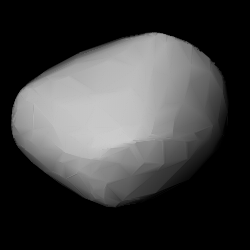Astronomy:1917 Cuyo
 Modelled shape of Cuyo from its lightcurve | |
| Discovery[1] | |
|---|---|
| Discovered by | C. U. Cesco A. G. Samuel |
| Discovery site | El Leoncito Complex |
| Discovery date | 1 January 1968 |
| Designations | |
| (1917) Cuyo | |
| Named after | Universidad Nacional de Cuyo[2] |
| 1968 AA | |
| Minor planet category | NEO · Amor[1][3] |
| Orbital characteristics[3] | |
| Epoch 27 April 2019 (JD 2458600.5) | |
| Uncertainty parameter 0 | |
| Observation arc | 65.08 yr (23,769 d) |
| Earliest precovery date | 6 May 1954 |
| |{{{apsis}}}|helion}} | 3.2353 AU |
| |{{{apsis}}}|helion}} | 1.0624 AU |
| 2.1488 AU | |
| Eccentricity | 0.5056 |
| Orbital period | 3.15 yr (1,151 d) |
| Mean anomaly | 129.40° |
| Mean motion | 0° 18m 46.44s / day |
| Inclination | 23.962° |
| Longitude of ascending node | 188.31° |
| 194.53° | |
| Earth MOID | 0.0716 AU (27.8938 LD) |
| Physical characteristics | |
| Mean diameter | 5.7 km[4] |
| Rotation period | 2.6890 h[5] |
| Geometric albedo | 0.195±0.032[4] |
| SMASS = Sl[3] | |
| Absolute magnitude (H) | 13.9[3] 14.3[1] |
1917 Cuyo (prov. designation: 1968 AA) is an stony asteroid and near-Earth object of the Amor group, approximately 5.7 kilometers (3.5 miles) in diameter. It was discovered on 1 January 1968, by astronomer Carlos Cesco and A. G. Samuel at El Leoncito Observatory, Argentina.[3]
Orbit and classification
Cuyo orbits the Sun at a distance of 1.1–3.2 AU once every 3 years and 2 months (1,151 days; semi-major axis of 2.15 AU). Its orbit has an eccentricity of 0.51 and an inclination of 24° with respect to the ecliptic.[3]
Naming
This minor planet is named in honor of the Universidad Nacional de Cuyo, which operated the observatory at El Leoncito in collaboration with Columbia and Yale University. Cuyo is also the name of a region in central-west Argentina.[2] The official naming citation was published by the Minor Planet Center on 1 June 1975 (M.P.C. 3828).[6]
Physical characteristics
SMASS classification Cuyo is a stony Sl-type.[3] In 1989, Cuyo was detected with radar from the Arecibo Observatory at a distance of 0.17 AU. The measured radar cross-section was 2.5 km2.[7] According to the survey carried out by NASA's Wide-field Infrared Survey Explorer with its subsequent NEOWISE mission, Cuyo measures 5.7 kilometers in diameter and its surface has an albedo of 0.195.[3]
References
- ↑ 1.0 1.1 1.2 "1917 Cuyo (1968 AA)". Minor Planet Center. https://www.minorplanetcenter.net/db_search/show_object?object_id=1917. Retrieved 21 October 2019.
- ↑ 2.0 2.1 Schmadel, Lutz D. (2007). Dictionary of Minor Planet Names – (1917) Cuyo. Springer Berlin Heidelberg. p. 154. doi:10.1007/978-3-540-29925-7_1918. ISBN 978-3-540-00238-3.
- ↑ 3.0 3.1 3.2 3.3 3.4 3.5 3.6 3.7 "JPL Small-Body Database Browser: 1917 Cuyo (1968 AA)". Jet Propulsion Laboratory. https://ssd.jpl.nasa.gov/sbdb.cgi?sstr=2001917. Retrieved 21 October 2019.
- ↑ 4.0 4.1 Nugent, C. R.; Mainzer, A.; Masiero, J.; Bauer, J.; Cutri, R. M.; Grav, T. et al. (December 2015). "NEOWISE Reactivation Mission Year One: Preliminary Asteroid Diameters and Albedos". The Astrophysical Journal 814 (2): 13. doi:10.1088/0004-637X/814/2/117. Bibcode: 2015ApJ...814..117N.
- ↑ "LCDB Data for (1917) Cuyo". Asteroid Lightcurve Database (LCDB). http://www.minorplanet.info/PHP/generateOneAsteroidInfo.php?AstInfo=1917%7CCuyo. Retrieved 21 October 2019.
- ↑ Schmadel, Lutz D. (2009). "Appendix – Publication Dates of the MPCs". Dictionary of Minor Planet Names – Addendum to Fifth Edition (2006–2008). Springer Berlin Heidelberg. p. 221. doi:10.1007/978-3-642-01965-4. ISBN 978-3-642-01964-7. Bibcode: 2009dmpn.book.....S. https://cds.cern.ch/record/1339661.
- ↑ Ostro, S. J.; Campbell, D. B.; Chandler, J. F.; Shapiro, I. I.; Hine, A. A.; Velez, R. et al. (October 1991). "Asteroid radar astrometry". The Astronomical Journal 102: 1490–1502. doi:10.1086/115975. ISSN 0004-6256. Bibcode: 1991AJ....102.1490O.
External links
- Asteroid Lightcurve Database (LCDB), query form (info )
- Dictionary of Minor Planet Names, Google books
- Asteroids and comets rotation curves, CdR – Observatoire de Genève, Raoul Behrend
- 1917 Cuyo at NeoDyS-2, Near Earth Objects—Dynamic Site
- Ephemeris · Obs prediction · Orbital info · MOID · Proper elements · Obs info · Close · Physical info · NEOCC
- 1917 Cuyo at ESA–space situational awareness
- 1917 Cuyo at the JPL Small-Body Database
 |

